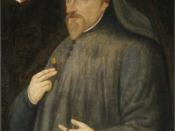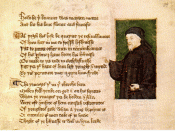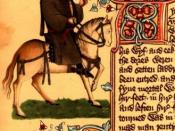In the Prologue to the Canterbury Tales, Geoffrey Chaucer presents a series of sketches on a diverse group of people during the medieval period. Through the portrayal of the Knight and the Squire, he vilifies the rapid decline of the aristocracy.
Chaucer introduces the Knight, the most socially prominent pilgrim as the epitome of knightly chivalry. He explains the Knight's qualities idealized by knighthood: "To ride abroad [he] had followed chivalry / Truth, honor, generousness and courtesy." The author therefore shows how the Knight perfectly conveys his values during the medieval period. Chaucer stresses that the Knight is a modest and refined gentlemen in the court: "And in his bearing modest as a maid / He never yet a boorish thing had said." He thus stresses the Knight's ideal characteristics. Chaucer shows the Knight's most moral value - his plain attire: "Speaking of his equipment, he possessed / Fine horses, but he was not gaily dressed."
This distinctly exemplifies the difference between the Knight's mentality and the Squire's, what's on the inside is more important than what's on the outside. Chaucer uses the Squire's outward appearance to clearly state how shallow he is in comparison to his father. He tells more about the Squire's social graces rather than his moral values to differentiate: "He could make songs and poems and recite / Knew how to joust and dance, to draw and write." The poet thus expresses the Squire in a more frivolous manner. Chaucer considers the Squire not valuing his honor the way he should: "He'd seen some service with the cavalry / In Flanders and Artois and Picardy / And had done valiantly in little space / Of time, in hope to win his lady's grace." He indicates that when the Squire fights in civil wars, he doesn't take...


